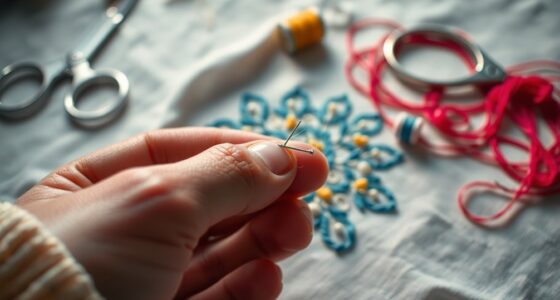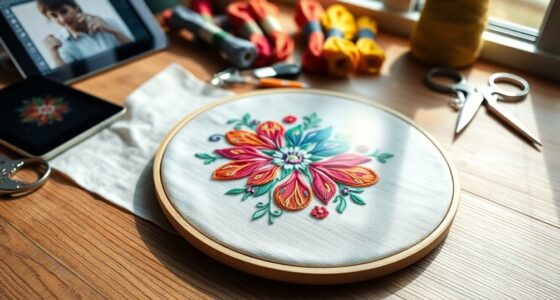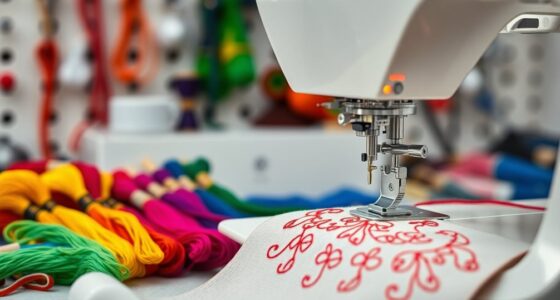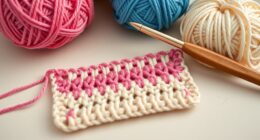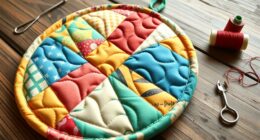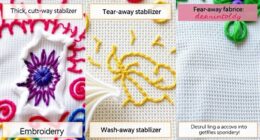To get started with machine embroidery, focus on maintaining your machine by cleaning lint, oiling it as recommended, and practicing correct threading and tension adjustments. Choose high-quality threads suited for your fabric, and experiment with different types like rayon, polyester, or metallics to achieve various effects. Using stabilizers helps prevent puckering, and practicing basic stitches builds your skills. Keep learning and experimenting, and you’ll find that mastering embroidery becomes more enjoyable and rewarding over time.
Key Takeaways
- Learn proper machine setup, threading, and tension adjustments to ensure smooth operation and quality stitches.
- Use high-quality threads compatible with your fabric and project for better results and machine longevity.
- Regularly clean and oil your embroidery machine to prevent issues like thread jams and mechanical failures.
- Practice with stabilizers and test stitches on scrap fabric to achieve desired effects and prevent puckering.
- Explore tutorials and resources to build skills, experiment with different threads and techniques, and develop your style.

Getting started with machine embroidery can be both exciting and overwhelming, especially if you’re new to the craft. The first step is understanding the importance of embroidery machine maintenance. Proper care guarantees your machine runs smoothly and produces professional-quality results. Always keep your machine clean by regularly removing lint and dust, especially around the bobbin area and under the needle plate. Use a small brush or compressed air to clear out debris, and oil your machine as recommended by the manufacturer. When you maintain your machine properly, you reduce the risk of thread jams, skipped stitches, or mechanical issues. Additionally, always use high-quality embroidery threads, as they impact the final look of your projects and the longevity of your machine. Choosing embroidery threads that are smooth, colorfast, and designed for machine use helps prevent breakage and tension problems. Experiment with different types of threads like rayon, polyester, or metallics to find what works best for your projects and aesthetic goals.
Once you understand how to keep your machine in good condition, you should focus on selecting the right embroidery threads. The type of thread you choose influences the texture, sheen, and durability of your embroidery. For beginners, polyester threads are often recommended because they’re strong, colorfast, and versatile. Rayon threads offer a beautiful sheen but can be more delicate, so they’re better suited for projects where appearance is a priority. Metallic threads add a touch of sparkle but require careful handling and proper tension adjustments. When choosing embroidery threads, also consider the weight or thickness, matching it with your fabric and design requirements. Thinner threads create delicate details, while thicker threads add boldness. Always check the thread’s compatibility with your embroidery machine and test on scrap fabric before starting your project to avoid surprises. Proper thread selection and maintenance are crucial for achieving professional-looking results.
Getting comfortable with your machine involves more than just maintenance and choosing threads. Practice threading your machine correctly, adjusting tension settings, and selecting appropriate needles for your project. Use stabilizers to support your fabric and prevent puckering. As you gain experience, you’ll learn how different threads and stabilizers interact, allowing you to troubleshoot issues more effectively. Remember, patience is key; embroidery is a skill that improves with practice. Keep your workspace organized, and store your threads properly to prevent tangling or damage. With consistent care and thoughtful thread selection, you’ll find that creating beautiful embroidered designs becomes more intuitive and enjoyable. Over time, you’ll develop your style and techniques, transforming your initial excitement into a rewarding hobby. Also, exploring machine embroidery supplies can help you find tools and materials that enhance your craft.
Frequently Asked Questions
What Are Essential Tools for Beginners in Machine Embroidery?
To start machine embroidery, you need essential tools like a variety of thread selection to match your projects, and different hoop sizes to accommodate various fabric sizes. You should also have sharp scissors, a water-soluble stabilizer, and a bobbin case. These tools help you achieve precise stitches, clean finishes, and smooth operation. With the right thread and hoop sizes, you’ll find it easier to create beautiful embroidery designs confidently.
How Do I Choose the Right Embroidery Machine for Beginners?
In the age of dial-up internet, choosing the right embroidery machine for beginners is essential. You want one that offers user-friendly features to master machine embroidery techniques. Look for reputable embroidery machine brands known for durability and support. Consider your budget and desired capabilities, like built-in designs or USB connectivity. A machine with adjustable speed and easy threading makes learning easier, helping you create beautiful projects from the start.
What Fabric Types Are Best Suited for Machine Embroidery?
You should choose fabrics like cotton, linen, or polyester blends for machine embroidery because they are stable and easy to work with. Always guarantee proper fabric stabilization to prevent puckering and use high-quality thread selection for smooth stitches. Avoid stretchy or delicate fabrics until you’re confident, as they can be challenging. By selecting the right fabric and stabilizer, your embroidery will look crisp and professional every time.
How Do I Troubleshoot Common Embroidery Machine Issues?
Imagine your embroidery machine as a delicate dance partner. When issues arise, start by checking tension adjustments, ensuring they’re not too tight or loose. Then, verify thread compatibility—using the right type and quality prevents snags and breaks. If stitches skip or fabric puckers, rethread your machine carefully and clean the bobbin area. Regular maintenance and patience help your machine perform smoothly, turning mishaps into seamless embroidery masterpieces.
Are There Free or Affordable Designs for Beginners to Practice?
Yes, you can find plenty of free patterns and beginner designs online to practice your machine embroidery skills. Websites like Embroidery Library, Urban Threads, and Pinterest offer free patterns suitable for beginners. You can also join online forums and social media groups where members often share free designs. These resources help you practice different stitches and techniques without spending a lot, making your embroidery journey more enjoyable and affordable.
Conclusion
Now that you’ve learned the basics, your journey into machine embroidery is just beginning. Imagine the endless designs and projects waiting for you to create—are you ready to access your full potential? The next step could be more exciting than you ever imagined. Keep practicing, stay curious, and prepare for surprises along the way. Your embroidery adventure is about to get even more interesting—are you prepared to see where it takes you?

